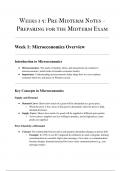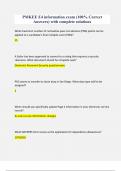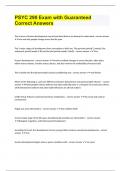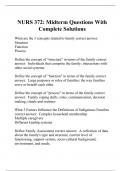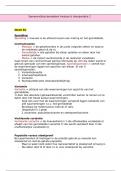1
Marketing and Persuasive Communication - ALL LECTURE NOTES
Lecture 1: Introduction:
Chapter 1: Introduction to Persuasion:
DEFINING PERSUASION:
A communication process in which the communicator
seeks to elicit a desired response from his receiver
(Andersen, 1971, p. 6).
A conscious attempt by one individual to change the
attitudes, beliefs, or behavior of another individual
or group of individuals through the transmission of some
message (Bettinghaus & Cody, 1987, p. 3).
A symbolic activity whose purpose is to affect the
internalization or voluntary acceptance of new
cognitive states or patterns of overt behavior through
the exchange of messages (Smith, 1982, p. 7).
A successful intentional effort at influencing
another’s mental state through communication in a
circumstance in which the persuadee has some measure of freedom (O’Keefe, 2016, p.
4).
A symbolic process in which communicators try to convince other people to change
their attitudes or behavior regarding an issue through the transmission of a message, in
an atmosphere of free choice (Lecture 1, sl. 41).
Perloff’s book:
● Examines persuasive communication and the dynamics of attitudes that
communicators hope to change.
● Takes you through theories, classic applications, and subtle implications of
the persuasion craft.
● Shows how you can use persuasion insights to become a more effective
persuasive speaker, a more critical judge of social influence attempts, and a
more sensitive, ethical communicator.
While persuasive messages are prepared by entrepreneurial individuals working
online, much persuasion continues to occur in organizational settings, with
, 2
high-powered companies playing an important role in the political and social
influence process.
Contemporary social media persuasive message effects are unique in that they:
a. Can involve simple catchphrases;
b. Diffuse more quickly and widely than previous technologies;
c. Enable others to participate in meaning conferral;
d. Are capable of mobilizing individuals across national boundaries.
Persuasive communication is:
● Broader than marketing communication.
● Foundation of most marketing communication.
● Present in spheres such as...
○ Corporate sphere.
○ Public sphere.
○ Individual sphere.
Marketing Communication is:
● Persuasive communication.
● Attention / awareness (memory effects).
● Consumer choice behavior (biases).
● Branding.
● Targeting strategy.
● Media influence (online vs offline).
Persuasion also involves the use of symbols. A symbol is a form of language in which
one entity represents a concept or idea, communicating rich psychological and cultural
meaning.
Persuasion VS Coercion: Persuasion deals with reason and verbal appeals, while
coercion employs force.
Coercion occurs when the influence agent:
A. Delivers a believable threat of significant physical or emotional harm to
those who refuse the directive.
B. Deprives the individual of some measure of freedom or autonomy.
C. Attempts to induce the individual to act contrary to her preferences.
, 3
Propaganda: form of communication in which the leaders of a ruling group have near
or total control over the transmission of information, typically relying on mass or
social media to reach target audience members, using language and symbols in a
deceptive and manipulative fashion.
Manipulation: a persuasion technique that occurs when a communicator hides his
or her true persuasive goals, hoping to mislead the recipient by delivering an
overt message that disguises its true intent. Flattery, sweet talk, and false promises
are manipulative techniques.
Three persuasive effects of communications:
1. Shaping.
2. Reinforcing.
3. Changing.
Chapter 2: Historical and Ethical Foundations:
, 4
Rhetoric: the use of argumentation, language, and public address to influence
audiences.
Aristotle’s treatise “Rhetoric” is regarded as “the most significant work on persuasion
ever written. Aristotle proposed that persuasion had three main ingredients:
Ethos: the nature of the communicator.
Pathos: the emotional state of the audience.
Logos: message arguments.
● From a historical perspective, the distinctive element of the persuasion
approach that began in the mid-20th century and continues today is its
empirical foundation.
● Knowledge is gleaned from observation and evidence rather than armchair
philosophizing. Researchers devise scientific theories, tease out hypotheses,
and dream up ways of testing them in real-world settings. No one—not the
Greeks, Romans, or 20th-century Western rhetorical theorists—had taken this
approach.
● Capitalizing on the development of a scientific approach to behavior, new
techniques for measuring attitudes, advances in statistics, and American
pragmatism, early researchers were able to forge ahead, asking new questions
and finding answers.
Kant’s deontological theory: The deontological approach argues that the moral value
of an act derives not from the consequence it produces, but in the intention from
which the act is performed.
Understanding Persuasion Ethics: Primer On Two Philosophical Theories:
Marketing and Persuasive Communication - ALL LECTURE NOTES
Lecture 1: Introduction:
Chapter 1: Introduction to Persuasion:
DEFINING PERSUASION:
A communication process in which the communicator
seeks to elicit a desired response from his receiver
(Andersen, 1971, p. 6).
A conscious attempt by one individual to change the
attitudes, beliefs, or behavior of another individual
or group of individuals through the transmission of some
message (Bettinghaus & Cody, 1987, p. 3).
A symbolic activity whose purpose is to affect the
internalization or voluntary acceptance of new
cognitive states or patterns of overt behavior through
the exchange of messages (Smith, 1982, p. 7).
A successful intentional effort at influencing
another’s mental state through communication in a
circumstance in which the persuadee has some measure of freedom (O’Keefe, 2016, p.
4).
A symbolic process in which communicators try to convince other people to change
their attitudes or behavior regarding an issue through the transmission of a message, in
an atmosphere of free choice (Lecture 1, sl. 41).
Perloff’s book:
● Examines persuasive communication and the dynamics of attitudes that
communicators hope to change.
● Takes you through theories, classic applications, and subtle implications of
the persuasion craft.
● Shows how you can use persuasion insights to become a more effective
persuasive speaker, a more critical judge of social influence attempts, and a
more sensitive, ethical communicator.
While persuasive messages are prepared by entrepreneurial individuals working
online, much persuasion continues to occur in organizational settings, with
, 2
high-powered companies playing an important role in the political and social
influence process.
Contemporary social media persuasive message effects are unique in that they:
a. Can involve simple catchphrases;
b. Diffuse more quickly and widely than previous technologies;
c. Enable others to participate in meaning conferral;
d. Are capable of mobilizing individuals across national boundaries.
Persuasive communication is:
● Broader than marketing communication.
● Foundation of most marketing communication.
● Present in spheres such as...
○ Corporate sphere.
○ Public sphere.
○ Individual sphere.
Marketing Communication is:
● Persuasive communication.
● Attention / awareness (memory effects).
● Consumer choice behavior (biases).
● Branding.
● Targeting strategy.
● Media influence (online vs offline).
Persuasion also involves the use of symbols. A symbol is a form of language in which
one entity represents a concept or idea, communicating rich psychological and cultural
meaning.
Persuasion VS Coercion: Persuasion deals with reason and verbal appeals, while
coercion employs force.
Coercion occurs when the influence agent:
A. Delivers a believable threat of significant physical or emotional harm to
those who refuse the directive.
B. Deprives the individual of some measure of freedom or autonomy.
C. Attempts to induce the individual to act contrary to her preferences.
, 3
Propaganda: form of communication in which the leaders of a ruling group have near
or total control over the transmission of information, typically relying on mass or
social media to reach target audience members, using language and symbols in a
deceptive and manipulative fashion.
Manipulation: a persuasion technique that occurs when a communicator hides his
or her true persuasive goals, hoping to mislead the recipient by delivering an
overt message that disguises its true intent. Flattery, sweet talk, and false promises
are manipulative techniques.
Three persuasive effects of communications:
1. Shaping.
2. Reinforcing.
3. Changing.
Chapter 2: Historical and Ethical Foundations:
, 4
Rhetoric: the use of argumentation, language, and public address to influence
audiences.
Aristotle’s treatise “Rhetoric” is regarded as “the most significant work on persuasion
ever written. Aristotle proposed that persuasion had three main ingredients:
Ethos: the nature of the communicator.
Pathos: the emotional state of the audience.
Logos: message arguments.
● From a historical perspective, the distinctive element of the persuasion
approach that began in the mid-20th century and continues today is its
empirical foundation.
● Knowledge is gleaned from observation and evidence rather than armchair
philosophizing. Researchers devise scientific theories, tease out hypotheses,
and dream up ways of testing them in real-world settings. No one—not the
Greeks, Romans, or 20th-century Western rhetorical theorists—had taken this
approach.
● Capitalizing on the development of a scientific approach to behavior, new
techniques for measuring attitudes, advances in statistics, and American
pragmatism, early researchers were able to forge ahead, asking new questions
and finding answers.
Kant’s deontological theory: The deontological approach argues that the moral value
of an act derives not from the consequence it produces, but in the intention from
which the act is performed.
Understanding Persuasion Ethics: Primer On Two Philosophical Theories:




